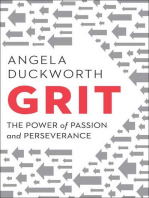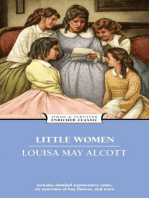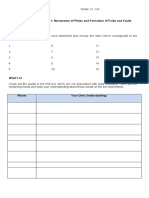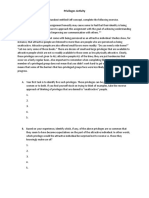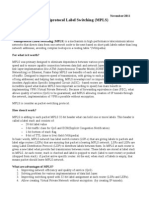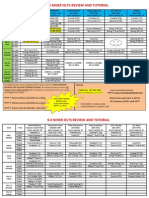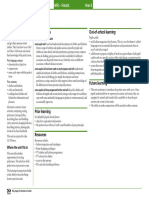Online/Blended Learning Competencies: Nikko Canda Bsedenglish MATH 145
Online/Blended Learning Competencies: Nikko Canda Bsedenglish MATH 145
Uploaded by
nikko canda0 ratings0% found this document useful (0 votes)
7 views5 pagesThis document discusses factors that can help students succeed in online learning during the pandemic. It identifies developing self-efficacy, setting goals, managing time well, and following academic standards as important skills. It also notes that the pandemic has led schools to provide more online instruction, which some students struggle with due to uneven internet access. However, fostering self-efficacy through mastery experiences, social modeling, and verbal persuasion can help students succeed. Additionally, the document outlines changes to the school calendar and curriculum to allow for flexible learning options like blended learning in response to the new normal under COVID-19.
Original Description:
Original Title
ENGLISH 134
Copyright
© © All Rights Reserved
Available Formats
DOCX, PDF, TXT or read online from Scribd
Share this document
Did you find this document useful?
Is this content inappropriate?
Report this DocumentThis document discusses factors that can help students succeed in online learning during the pandemic. It identifies developing self-efficacy, setting goals, managing time well, and following academic standards as important skills. It also notes that the pandemic has led schools to provide more online instruction, which some students struggle with due to uneven internet access. However, fostering self-efficacy through mastery experiences, social modeling, and verbal persuasion can help students succeed. Additionally, the document outlines changes to the school calendar and curriculum to allow for flexible learning options like blended learning in response to the new normal under COVID-19.
Copyright:
© All Rights Reserved
Available Formats
Download as DOCX, PDF, TXT or read online from Scribd
Download as docx, pdf, or txt
0 ratings0% found this document useful (0 votes)
7 views5 pagesOnline/Blended Learning Competencies: Nikko Canda Bsedenglish MATH 145
Online/Blended Learning Competencies: Nikko Canda Bsedenglish MATH 145
Uploaded by
nikko candaThis document discusses factors that can help students succeed in online learning during the pandemic. It identifies developing self-efficacy, setting goals, managing time well, and following academic standards as important skills. It also notes that the pandemic has led schools to provide more online instruction, which some students struggle with due to uneven internet access. However, fostering self-efficacy through mastery experiences, social modeling, and verbal persuasion can help students succeed. Additionally, the document outlines changes to the school calendar and curriculum to allow for flexible learning options like blended learning in response to the new normal under COVID-19.
Copyright:
© All Rights Reserved
Available Formats
Download as DOCX, PDF, TXT or read online from Scribd
Download as docx, pdf, or txt
You are on page 1of 5
Nikko Canda BSEDENGLISH
MATH 145
CHAPTER II
REVIEW OR RELATED LITERATURE
Online/Blended Learning Competencies
The 1st part of the literature review is about the factors
affecting student performance, but now we will focus
factors/motivators that may help contribute to successful learning
experiences amidst the new normal. Michael, Gila, Insung,
Katsuaki, and Barbara (2013) stated that because of this flexible,
open and extended nature of online learning environment, it is
important for learners to set realistic expectations for their own
online study and maintain goal-oriented attitudes. They should also
be about to meet various challenges and manage time well.
Learners are obliged to comply with academic and ethical practices,
and respect legal standards. Learners should also acquire a
sufficient level of technical knowledge and skills. This is a helpful
guideline that help improve the learning experience for students in
the new normal.
Self-efficacy in the New Normal
The coronavirus pandemic has spawned a consequent concern
of our educational institutions to carry on their respective missions
by providing on-line learning sessions. With this format, there are
among our students who feel inadequate to attend to their assigned
readings in their subjects. They have been used to their lecturers
explain to them in more informal ways the website material. While
there are apps to remedy these virtual class sessions, such as
virtual interchange through chats or Zoom or Google classroom,
these apps though available, are not always readily accessible
because of the unevenness of internet accessibility. However,
besides innovative on-line activities, there is one other thing to
assist them with, that is, by fostering in them self-efficacy.
Psychologists likewise stress Bandura’s time-tested theory that
mastery experiences are the most effective way in building one’s
self-efficacy. Vicarious experiences that social models provided are
also a source of inspiration. They strengthen one’s self-beliefs of
efficacy. Verbal persuasion, such as words of encouragement from a
trusted friend or higher up, such as one’s professor or boss
confirming confidence in one’s ability, is another way of building
one’s beliefs of one’s self-efficacy.
A face of education under the new normal
The move to change the academic calendar year from June to
August 2020 is consistent with Section 3 of Republic Act No. 7797,
otherwise known as “An Act to Lengthen the School Calendar from
200 Days to Not More than 220 Class Days.” The law states that the
school year, effective 1995-96, shall start on the first Monday of
June but not later than the last day of August. In the
implementation of this Act, the Secretary of the Department of
Education, Culture and Sports (DECS), now the Department of
Education (DepEd), shall determine the end of the regular school
year. All higher education institutions (HEIs) are also obliged to
follow the provisions of this law. In some remote areas or barangays
without internet connectivity but without the presence of COVID-19
case since the start of pandemic may go offline or blended learning
system. These public and private schools should be ready to
implement flexible learning as an alternative to traditional
classroom learning before the start of classes. This includes having
their lesson through radio, television or cellular phones as what is
applicable in the area where the learning process takes place. For
this reason there might be changes in the contents of school
curriculum, syllabi, lesson planning and scheduling of classes.
Various learning delivery options such as but not limited to face-to-
face, blended learnings, distance learnings, homeschooling and
other modes of delivery shall be adopted. The possibility of
alternating school days for students or staggered conduct of classes
is also pushed by some of our authorities in education. This is to
decongest the number of students inside the classroom and ensure
the students and teachers’ safety in school areas with physical
attendance. In schools where face-to-face modality is allowed, there
shall be a maximum of 15 to 20 learners in a class. This is in
compliance with the social distancing measures set by the
Department of Health (DOH).
You might also like
- The Subtle Art of Not Giving a F*ck: A Counterintuitive Approach to Living a Good LifeFrom EverandThe Subtle Art of Not Giving a F*ck: A Counterintuitive Approach to Living a Good LifeRating: 4 out of 5 stars4/5 (5866)
- The Gifts of Imperfection: Let Go of Who You Think You're Supposed to Be and Embrace Who You AreFrom EverandThe Gifts of Imperfection: Let Go of Who You Think You're Supposed to Be and Embrace Who You AreRating: 4 out of 5 stars4/5 (1094)
- Never Split the Difference: Negotiating As If Your Life Depended On ItFrom EverandNever Split the Difference: Negotiating As If Your Life Depended On ItRating: 4.5 out of 5 stars4.5/5 (866)
- Grit: The Power of Passion and PerseveranceFrom EverandGrit: The Power of Passion and PerseveranceRating: 4 out of 5 stars4/5 (597)
- Hidden Figures: The American Dream and the Untold Story of the Black Women Mathematicians Who Helped Win the Space RaceFrom EverandHidden Figures: The American Dream and the Untold Story of the Black Women Mathematicians Who Helped Win the Space RaceRating: 4 out of 5 stars4/5 (909)
- Shoe Dog: A Memoir by the Creator of NikeFrom EverandShoe Dog: A Memoir by the Creator of NikeRating: 4.5 out of 5 stars4.5/5 (543)
- The Hard Thing About Hard Things: Building a Business When There Are No Easy AnswersFrom EverandThe Hard Thing About Hard Things: Building a Business When There Are No Easy AnswersRating: 4.5 out of 5 stars4.5/5 (352)
- Elon Musk: Tesla, SpaceX, and the Quest for a Fantastic FutureFrom EverandElon Musk: Tesla, SpaceX, and the Quest for a Fantastic FutureRating: 4.5 out of 5 stars4.5/5 (474)
- Her Body and Other Parties: StoriesFrom EverandHer Body and Other Parties: StoriesRating: 4 out of 5 stars4/5 (824)
- The Emperor of All Maladies: A Biography of CancerFrom EverandThe Emperor of All Maladies: A Biography of CancerRating: 4.5 out of 5 stars4.5/5 (272)
- The Sympathizer: A Novel (Pulitzer Prize for Fiction)From EverandThe Sympathizer: A Novel (Pulitzer Prize for Fiction)Rating: 4.5 out of 5 stars4.5/5 (122)
- The Little Book of Hygge: Danish Secrets to Happy LivingFrom EverandThe Little Book of Hygge: Danish Secrets to Happy LivingRating: 3.5 out of 5 stars3.5/5 (411)
- The Yellow House: A Memoir (2019 National Book Award Winner)From EverandThe Yellow House: A Memoir (2019 National Book Award Winner)Rating: 4 out of 5 stars4/5 (98)
- The World Is Flat 3.0: A Brief History of the Twenty-first CenturyFrom EverandThe World Is Flat 3.0: A Brief History of the Twenty-first CenturyRating: 3.5 out of 5 stars3.5/5 (2268)
- Devil in the Grove: Thurgood Marshall, the Groveland Boys, and the Dawn of a New AmericaFrom EverandDevil in the Grove: Thurgood Marshall, the Groveland Boys, and the Dawn of a New AmericaRating: 4.5 out of 5 stars4.5/5 (268)
- A Heartbreaking Work Of Staggering Genius: A Memoir Based on a True StoryFrom EverandA Heartbreaking Work Of Staggering Genius: A Memoir Based on a True StoryRating: 3.5 out of 5 stars3.5/5 (232)
- Team of Rivals: The Political Genius of Abraham LincolnFrom EverandTeam of Rivals: The Political Genius of Abraham LincolnRating: 4.5 out of 5 stars4.5/5 (235)
- On Fire: The (Burning) Case for a Green New DealFrom EverandOn Fire: The (Burning) Case for a Green New DealRating: 4 out of 5 stars4/5 (74)
- Habermas - On Systematically Distorted CommunicationDocument7 pagesHabermas - On Systematically Distorted CommunicationAndré MagnelliNo ratings yet
- The Unwinding: An Inner History of the New AmericaFrom EverandThe Unwinding: An Inner History of the New AmericaRating: 4 out of 5 stars4/5 (45)
- Exception CodesDocument7 pagesException Codesjamos200No ratings yet
- 4 Curriculum DevelopmentDocument7 pages4 Curriculum Developmentnikko candaNo ratings yet
- 14Document25 pages14nikko candaNo ratings yet
- 2 Teaching-Learning StrategiesDocument10 pages2 Teaching-Learning Strategiesnikko candaNo ratings yet
- 11Document8 pages11nikko candaNo ratings yet
- Professional Education LET ReviewerDocument34 pagesProfessional Education LET Reviewernikko candaNo ratings yet
- 12Document5 pages12nikko candaNo ratings yet
- 2Document6 pages2nikko candaNo ratings yet
- 3.1 Learning CompetencyDocument2 pages3.1 Learning Competencynikko candaNo ratings yet
- Opportunities, Challenges and Power of Media and InformationDocument3 pagesOpportunities, Challenges and Power of Media and Informationnikko candaNo ratings yet
- 4Document6 pages4nikko candaNo ratings yet
- Activity Sheets in Assessment 6-28Document27 pagesActivity Sheets in Assessment 6-28nikko candaNo ratings yet
- Earth and Life Science Module 7Document11 pagesEarth and Life Science Module 7nikko candaNo ratings yet
- CPR BrochureDocument2 pagesCPR Brochurenikko candaNo ratings yet
- Plane Geometry ActivityDocument4 pagesPlane Geometry Activitynikko candaNo ratings yet
- MODULE 1 LESSON 4: Module Assessment Task: Activity 1Document2 pagesMODULE 1 LESSON 4: Module Assessment Task: Activity 1nikko candaNo ratings yet
- Performance Task FinalDocument2 pagesPerformance Task Finalnikko candaNo ratings yet
- College of Eastern Idaho "Privileges Activity"Document3 pagesCollege of Eastern Idaho "Privileges Activity"The College FixNo ratings yet
- Session Guide On Classroom Routines 2018Document6 pagesSession Guide On Classroom Routines 2018Ann A. Saavedra100% (1)
- Evolution of The TelevisionDocument10 pagesEvolution of The TelevisionMikin KaushikNo ratings yet
- A Position Paper About Using Cellphone in ClassbyDocument2 pagesA Position Paper About Using Cellphone in ClassbyJennifer Consarba100% (4)
- Fake It Till You Make ItDocument3 pagesFake It Till You Make ItMicah YapNo ratings yet
- MPLSDocument1 pageMPLSArmin KobilicaNo ratings yet
- 2nd WeekDocument2 pages2nd WeekreginemyfaveNo ratings yet
- Sales LetterDocument4 pagesSales LettervarunatorNo ratings yet
- Rubric For Recorded Oral Reports in Tle 8Document1 pageRubric For Recorded Oral Reports in Tle 8Welfredo Jr YuNo ratings yet
- 24 Full Chinapat Eksathit OnlineDocument5 pages24 Full Chinapat Eksathit OnlineKumari AnanditaNo ratings yet
- Lesson Plan - M LetterDocument3 pagesLesson Plan - M Letterapi-350255036No ratings yet
- NSTP 2 - Civic Welfare Training Service 2Document6 pagesNSTP 2 - Civic Welfare Training Service 2jonalyn obina0% (1)
- Arduino Whatsapp Messages Send Whatsapp Messages UDocument4 pagesArduino Whatsapp Messages Send Whatsapp Messages UFajar Arif PermataNo ratings yet
- Teacher's Notes: Can Justify and Sustain Views Clearly by Providing Relevant Explanations and ArgumentsDocument3 pagesTeacher's Notes: Can Justify and Sustain Views Clearly by Providing Relevant Explanations and ArgumentsAnonymous vqzyDYXkNo ratings yet
- Sanskrit - Docx 2Document2 pagesSanskrit - Docx 2Atul TiwariNo ratings yet
- Bars - DLDocument12 pagesBars - DLSimone BandrawalaNo ratings yet
- Perfect Digital Marketing StrategyDocument5 pagesPerfect Digital Marketing Strategyabhay palNo ratings yet
- Grades 1 To 12: Daily Lesson LogDocument3 pagesGrades 1 To 12: Daily Lesson LogBernadette Tan RochaNo ratings yet
- Reading Promoting The StarsDocument1 pageReading Promoting The StarsAndrea MeijomilNo ratings yet
- Advans MDW RDocument10 pagesAdvans MDW Rcalloflove4uNo ratings yet
- Albis Datasheet BSTUDocument2 pagesAlbis Datasheet BSTUPedro VicenteNo ratings yet
- Mff11 Clothes and FashionDocument4 pagesMff11 Clothes and FashionGabriela MccawleyNo ratings yet
- Script For VlogDocument3 pagesScript For VlogAlex HCNo ratings yet
- Research Proposal: Chapter 1Document7 pagesResearch Proposal: Chapter 1mirashikaNo ratings yet
- Japanese Classes in Toyohashi: (English)Document1 pageJapanese Classes in Toyohashi: (English)Kadek DwiardianaNo ratings yet
- Plants LessonDocument3 pagesPlants Lessonapi-616543172No ratings yet
- AnubDocument2 pagesAnubOnecup RiceNo ratings yet
- College of EngineeringDocument3 pagesCollege of EngineeringTemitayo EjidokunNo ratings yet






